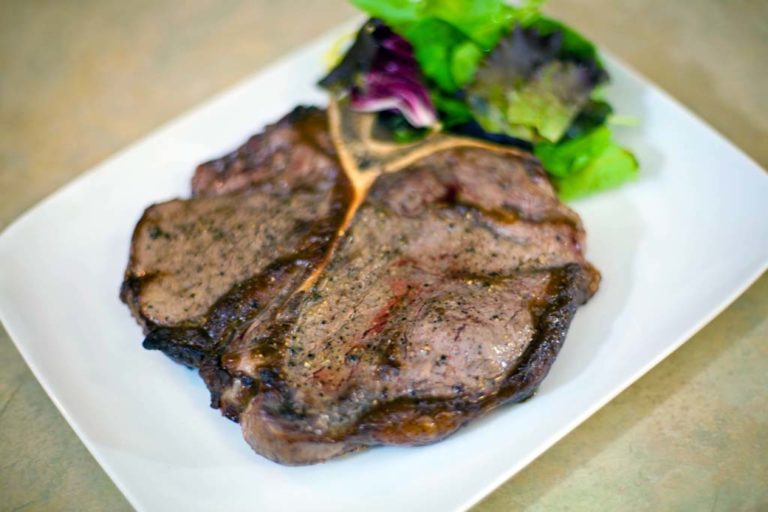
Chef's notes:
The porterhouse steak comes from the rear part of the strip loin. It is so close to the sirloin that often porterhouses are called sirloins and vice versa. Either way, look for a porterhouse with lots of tenderloin. The tenderloin is, by far, the better half of a porterhouse. That bone running down the middle of the porterhouse is part of the vertebrae and called the transverse process. The hole on the top of the T is the vertebrae foramen, where the spinal cord runs through.
Ingredients
- 2 porterhouse steaks
- Olive oil
- Sea salt
- Black pepper
Thick-Cut Porterhouse Steak Seasoned with Sea Salt, Black Pepper and Broiled with Olive Oil
- Pick up some porterhouse steaks. It can be difficult to find decent porterhouses. It seems that some butchers have a different idea of what thickness to cut a porterhouse. Especially for broiling, but also for grilling, you want thick steaks, where it may take longer to crisp up the outside. The steaks I used here were around 1½ inches thick.
- Season the porterhouse steaks for broiling. Since these steaks are fairly expensive, and coincidentally also very tasty, I recommend that you season them simply with salt and pepper. Rub in a liberal amount of both, and follow it up with a light coating of vegetable oil. The oil will help brown the exterior of the steaks when the cook. Turn the broiler on high and move the oven rack to the second position from the top.
- Broil the porterhouse steaks. Put the steaks under the broiler and close the door. If you haven’t broiled too much, keep an eye on them as they cook. After a few minutes, they should start to look like the steaks in the picture to the right. Take them out and flip them over with the tongs. Turn on a fan or vent to deal with the unavoidable smoke.
- Use a digital thermometer to judge when the broiled steaks are done. Stick the thermometer in the side of the steak, toward the middle. For rare steaks, cook to 120–125 degrees F, medium rare to 130–140, medium to 140–150, medium well to 150–160, and well done to over 160. Once the porterhouses are broiled to your preference, rest them on a wire rack for 8–9 minutes before eating. This will help the steak stay juicy when you cut into it.
Tips & Tricks
- Find porterhouses that are at least 1½–2 inches thick. This will help you get the outside crusty without overcooking the inside.
- Ask the butcher to let you smell the meat before you buy it. If it smells sour, don’t buy it.
- I usually recommend using vegetable oil to rub on steaks, but it you are using an electric broiler, olive oil may actually work better. Olive oil has a lower flash point, so it may brown the meat quicker. Since electric broilers are wimpy, this will help.
- Not all oven broilers are created equally. If you haven’t used your broiler before, keep an eye on the steaks as they cook.
- As the steaks rest, you can loosely cover them with a little aluminum foil to keep them from getting too cold. Don’t seal them up or you risk ruining the crust on the outside.
